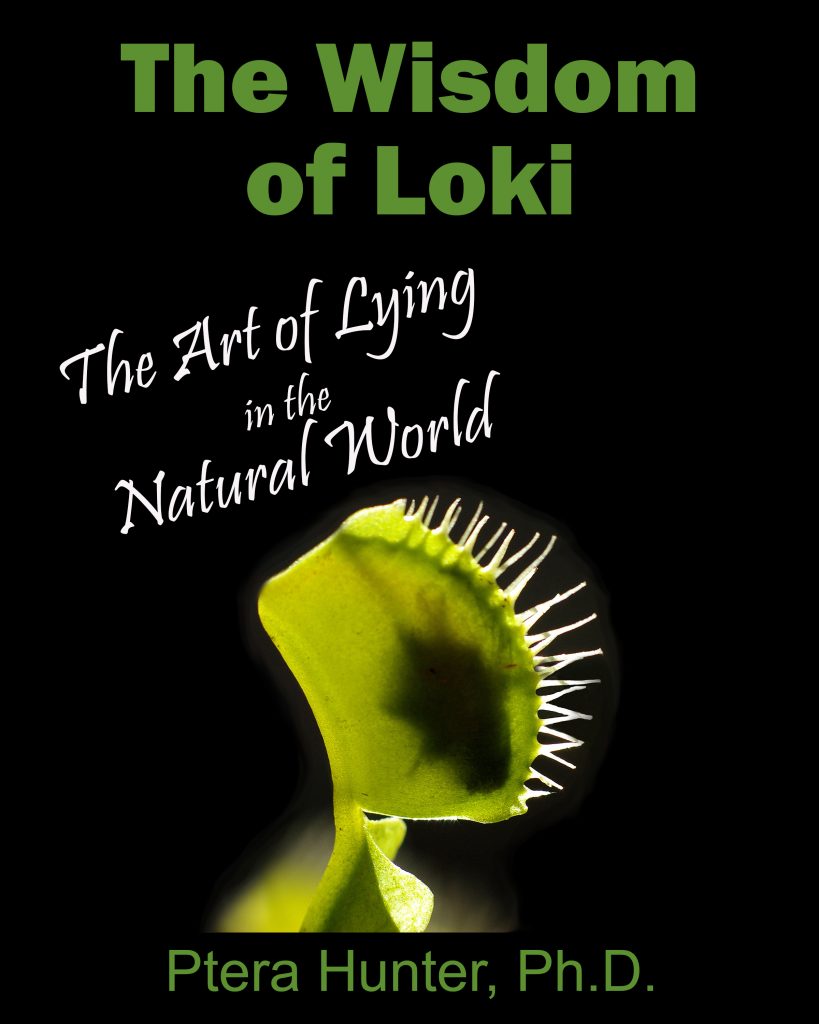
Everything lies. For virtually every species, lying and lie detection are essential survival skills. Organisms lie, exaggerate, and scam their way to food, to territory and to sex. Both plants and animals lie to become invisible or to increase visibility. We humans pretend we mean no harm when we intend to maim or to kill. Duped individuals can become dinners rather than dates, the biological fall guys for their fellow creatures. Even our own bodies lie to us, convincing us either that our lives’ experiences come to us in unique visions or that our partners feel precisely the same way we do. After reading this book, you will have lie-detection skills that can help you understand your fellow man, your children, and even your orchids.
Buy The Wisdom of Loki on Amazon
About Ptera Hunter
Excerpt from The Wisdom of Loki: The Art of Lying in the Natural World
Miscommunication has an extreme adaptive advantage. Signals can misdirect the receiver and cloak the real intent of the signaler. When biologists first studied the origins of communication, they looked at those specific points where interests overlapped. These biased selections of data led them to believe that accurate communication was the norm.
They were wrong. Among animals, conflict over resources and diverging interests are at least as frequent as converging interests. When we think about communication in this light, it becomes far more interesting. Here is where lying comes into its own. Conflicts over resources are so pervasive in the natural world that deceit is not just an option. Deceitfulness and lie-detection are both essential survival skills.
The elk that signals dominance with a long bray needs to fight less often than the elk that does not signal a tough-guy attitude. With a good bluff, he can usually avoid a costly fight. Fiddler crabs that have lost a claw will re-grow a bigger but weaker claw. When challenged by a smaller crab, the weak-clawed fiddler will bluff. It will display a fighting stance that tells the smaller crab that a confrontation would be foolish (6).
As we learn to lie, we also learn to become lie detectors (7). Any animal that cannot tell a bluff from an honest signal is at a considerable disadvantage. Bolo spiders successfully hunt their moth prey because they produce a false mating signal that lures local male moths into their traps (8). In one species of firefly, (genus Photuris) females can dine on the males of another species for this same reason: they send a phony mating signal to the other species (9; 10; 11; 12; 13). The duped male becomes dinner rather than a date.
As predators become better tricksters, they change the selection pressure on their prey. Prey who can detect the predators, the better lie-detectors, survive to reproduce (16). The reverse is also true. Predators must learn to see through the tricks of the prey. The better the illusion, the more attentive the predator must be. In this way, systems of liars and lie-detectors can push their participants toward more extreme miscommunication.
This system can spiral out of control, just like some other animals—such as elephants and Apatosaurus—got stuck on a path toward more extreme size to avoid predation (18), or—like the peacock—got trapped in a cycle of ever greater ornamentation to attract more and more selective mates. Circumstance forced each of these species into their own biological arms race. None of them could end this race for survival without suffering the consequences: extinction.
6. Regenerated claws dishonestly signal performance and fighting ability in the fiddler crab Uca mjoebergi. Lailvaux, S. P., Reaney, L. T. and Blackwell, P. R. Y. 2, 2009, Functional Ecology, Vol. 32, pp. 359-366.
7. Vasek, M. E. Lying as a skill: the development of deception in children. 271-293. [book auth.] R. W. Mitchell and N. S. Thompson. Deception: Perspectives on Human and Nonhuman Deceit. Albany : State University of New York Press, 1986, 16, p. 418.
8. Aggressive Chemical Mimicry by the Bolas Spider Mastophora hutchinsoni: Identification and Quantification of a Major Prey's Sex Pheromone Components in the Spider's Volatile Emissions. Gemeno, C., Yergan, K. V. and Haynes, K. F. 5, 2000, Journal of Chemical Ecology, Vol. 26, pp. 1235-1243.
9. Firefly femmes fatales: A case study in the semiotics of deception. Biosemiotics. El-Hani, C. N., Queiroz, J. and Stjernfelt, F. 1, 2009, Biosemiotics, Vol. 3, pp. 33-55.
10. Notes on the biology of some common Lampyridae. Hess, W. N. 2, 1920, Biological Bulletin, Vol. 38, pp. 39-76.
11. Aggressive mimicry in Photuris: Firefly Femmes Fatales. Lloyd, J. E. 3684, 1965, Science, Vol. 149, pp. 635-654.
12. Occurrence of aggressive mimicry in fireflies. Lloyd, J. E. 3, 1984, Florida Entomologist, Vol. 67, pp. 368-376.
13. Firefly semiosystematics and predation: a history. Lloyd, J. E. 1, 1990, The Florida Entomologist, Vol. 73, pp. 51-66.
16. Arms races between and within species. Dawkins, R. and Krebs, J. R. 1161, 1979, Proceedings of the Royal Society B: Biological Sciences, Vol. 205, pp. 489-511.
18. The evolution of large size: how does Cope's Rule work? Hone, D. W. and Benton, M. J. 1, 2005, Trends in Ecology and Evolution, Vol. 20, pp. 4–6.